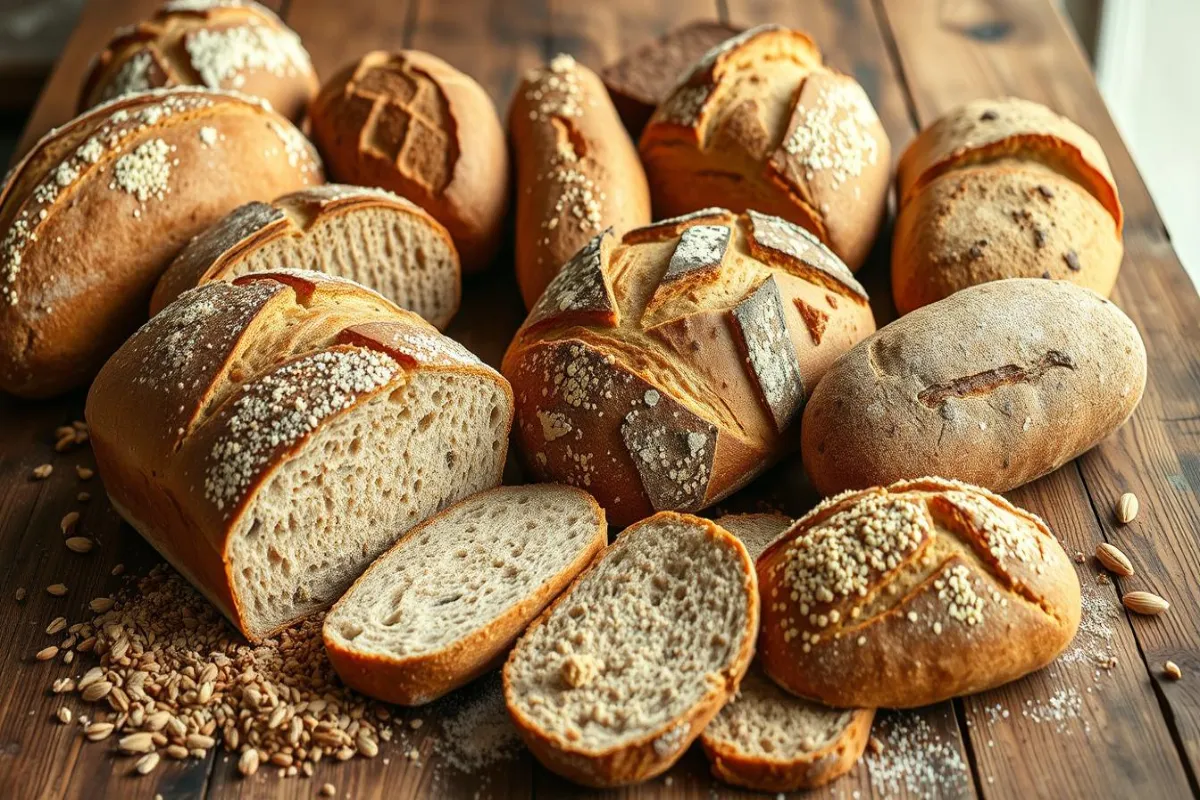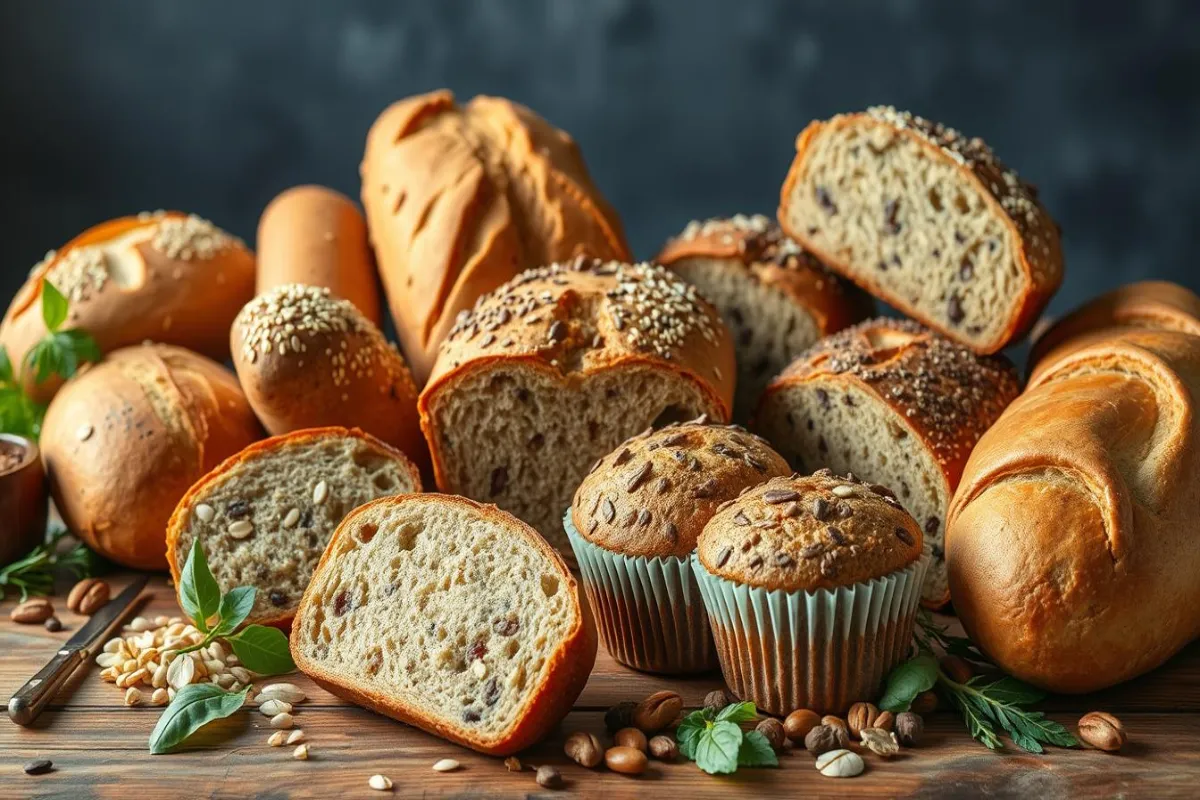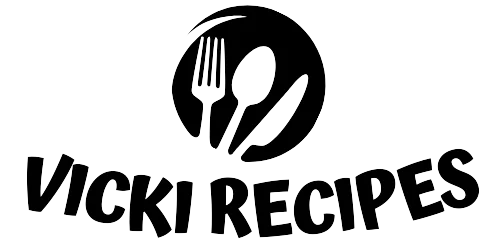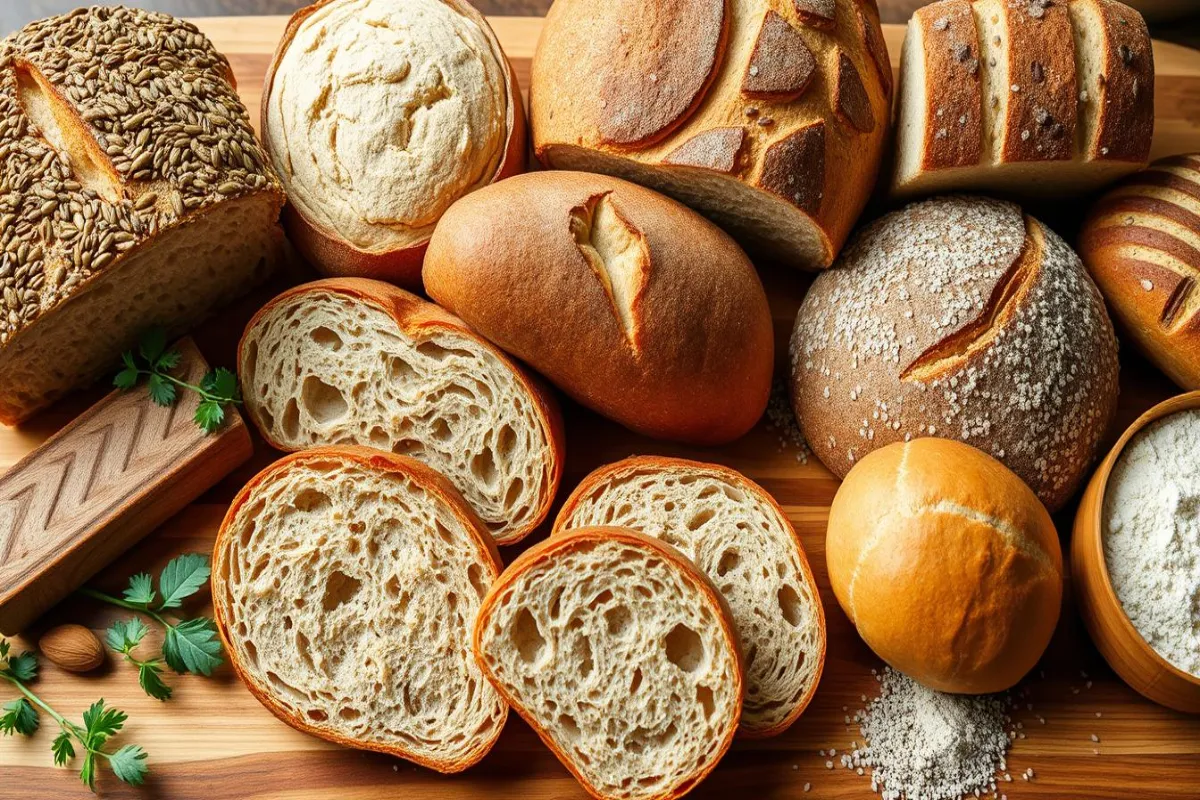I’m excited to share my insights on the best gluten-free bread options. Whether you have celiac disease, a gluten intolerance, or just want to eat less gluten, this guide is for you. You’ll find top gluten-free bread brands and tasty gluten-free bread recipes here.
We’ll explore the world of healthy gluten-free bread together. You’ll learn about the special ingredients and how these breads are made. We’ll also talk about the benefits of gluten-free diets and lifestyles and the leading brands in this market.
Plus, we’ll dive into the gluten-free bread nutrition, gluten-free bread taste, and gluten-free bread texture. This will help you make choices that fit your diet and health goals.
So, whether you’re already a fan of gluten-free bread or just starting out, join me on this food journey. Get ready to find the best gluten-free bread reviews and discover a world of tasty, healthy gluten-free bread.
What is Gluten-Free Bread?
Gluten-free bread doesn’t have the protein gluten, found in wheat, barley, and rye. It’s great for people with celiac disease, gluten intolerance, or those on a gluten-free diet. More people are trying it because they see its benefits.
Understanding the Difference from Traditional Bread
Gluten-free bread and traditional bread differ mainly in ingredients. Traditional bread uses wheat flour, but gluten-free bread uses flours like rice, almond, or tapioca. These flours don’t have gluten, making gluten-free bread unique.
The Rise of Gluten-Free Diets and Lifestyles
Gluten-free diets and lifestyles are becoming more popular. People follow them for health reasons, like managing celiac disease or gluten intolerance. This has led to more gluten-free products, including bread, being available.
“Gluten-free bread is a game-changer for those with dietary restrictions, allowing them to enjoy the taste and texture of bread without the negative health consequences.”

The Benefits of Choosing Gluten-Free Bread
Switching to gluten-free bread can greatly improve your health. It helps with digestion and lets you enjoy food without worrying about allergies. These benefits make gluten-free bread a great choice for many.
Improved Digestive Health
Gluten-free bread is a big help for those with gluten issues. It removes the protein that causes problems in regular bread. This can make your stomach feel better, leading to a healthier gut.
Allergen-Free Eating
For people with food allergies, gluten-free bread is a safe and tasty option. Unlike regular bread, it doesn’t have common allergens like dairy or eggs. This makes it easier for those with dietary restrictions to enjoy bread.
“Switching to gluten-free bread has been a game-changer for my digestive health. I no longer suffer from the discomfort and bloating I experienced with regular bread, and I can finally enjoy eating without worry.”
Looking to better your digestion or find allergen-friendly food? Gluten-free bread is a step towards a healthier life. It can make a big difference in how you feel and eat.

Top Gluten-Free Bread Brands
Looking for the best gluten-free bread? There are several top brands known for quality, taste, and texture. Let’s explore some leading brands and what makes them special.
Udi’s Gluten Free is a favorite for its soft, fluffy bread and tasty flavors. They offer a variety of breads, including sandwich bread, bagels, and baguettes. Their breads are made with gluten-free ingredients and don’t have artificial preservatives.
Canyon Bakehouse is another trusted brand. They focus on using non-GMO ingredients in their breads. You can find everything from classic white to seeded multi-grain breads. Their breads are known for their soft, homemade texture.
| Brand | Product Offerings | Unique Features |
|---|---|---|
| Udi’s Gluten Free | Sandwich bread, bagels, baguettes | Soft, fluffy texture, delicious flavors, no artificial preservatives |
| Canyon Bakehouse | Sandwich bread, rolls, buns | Wholesome, non-GMO ingredients, soft, homemade-like texture |
| Schar | Sandwich bread, rolls, crackers | European-inspired recipes, wide range of gluten-free products |
| Glutino | Sandwich bread, bagels, English muffins | Certified gluten-free, kosher, and non-GMO |
Other brands like Schar and Glutino are also worth checking out. Schar is known for its European recipes and wide product range. Glutino offers certified gluten-free, kosher, and non-GMO bread options.
When choosing a gluten-free bread brand, think about the ingredients, taste, texture, and variety. Find the brand that fits your dietary needs and preferences best.
Best Gluten Free Bread
Finding the “best” gluten-free bread can be tricky. People have different tastes and needs. I’ll share some top picks, focusing on taste, texture, and nutrition.
The Udi’s Gluten Free Millet-Chia Sandwich Bread is a favorite. It’s soft, fluffy, and has a nutty taste. Plus, it’s full of fiber and free from artificial preservatives.
The Canyon Bakehouse Gluten-Free Heritage Style Bread is another great choice. It tastes and feels like regular sandwich bread. People love how it holds up to fillings without falling apart.
| Brand | Key Features | Customer Ratings |
|---|---|---|
| Udi’s Gluten Free Millet-Chia Sandwich Bread | Soft and fluffy texture, nutty flavor, good source of fiber, no artificial preservatives | 4.6 out of 5 stars |
| Canyon Bakehouse Gluten-Free Heritage Style Bread | Classic sandwich bread taste and texture, holds up well to fillings | 4.7 out of 5 stars |
If you want something healthier, try the Barely Bread Gluten-Free Almond Bread. It’s made with almond flour, eggs, and coconut oil. It’s packed with protein and healthy fats.
“I’ve tried so many gluten-free breads, and this is by far the best one I’ve found. It has a great texture and actually tastes good!”
What’s the “best” gluten-free bread for you? It depends on your taste and dietary needs. Look at taste, texture, and nutrition to find your perfect match.
Gluten-Free Bread Ingredients
Making gluten-free bread is all about choosing the right ingredients. We pick flour alternatives and nutritious items carefully. These ingredients work together to make the bread tasty and healthy for those who can’t eat gluten.
Common Flour Alternatives
Gluten-free bread recipes use a mix of flours to replace wheat flour. Here are some common ones:
- Rice flour: It’s light and airy, making the bread soft.
- Almond flour: It adds a nutty taste and makes the bread moist.
- Coconut flour: It’s good for those watching carbs and makes the bread absorbent.
- Tapioca flour: It helps the bread stay elastic and structured.
- Buckwheat flour: It gives a unique flavor and adds heartiness.
Additional Nutritious Ingredients
Gluten-free bread also gets a nutritional boost from extra ingredients. These include:
- Chia seeds or flaxseeds: They’re full of omega-3s and fiber.
- Quinoa: It’s a complete protein that adds crunch.
- Nuts and seeds: They add healthy fats, protein, and texture.
- Psyllium husk: It helps the bread’s structure and digestion.
- Nutritional yeast: It adds a savory flavor and B vitamins.
By mixing these ingredients, bakers make bread that tastes great and is good for you.
| Gluten-Free Flour Alternative | Key Characteristics |
|---|---|
| Rice Flour | Provides structure and a light, airy crumb |
| Almond Flour | Offers a nutty flavor and a moist, tender texture |
| Coconut Flour | Known for its absorbent properties and low-carb content |
| Tapioca Flour | Used to enhance elasticity and improve overall structure |
| Buckwheat Flour | Provides a unique, earthy flavor and a touch of heartiness |
“Gluten-free baking is an art, and the right combination of flour alternatives and nutritious add-ins can create a masterpiece.”
Homemade Gluten-Free Bread Recipes
If you want to bake your own gluten-free bread, I have some easy recipes for you. These are great for beginners. I’ll guide you through making tasty, homemade gluten-free bread that’s as good as store-bought.
Gluten-Free Sandwich Bread
This recipe is perfect for making sandwich bread. It uses simple ingredients to create a soft, fluffy loaf. It’s great for toast, sandwiches, and more. Here’s how to make it:
- Preheat your oven to 375°F (190°C) and grease a loaf pan.
- In a large bowl, mix 2 cups of gluten-free flour blend, 1 teaspoon of baking powder, 1/2 teaspoon of salt, and 1 tablespoon of sugar.
- In another bowl, whisk together 1 cup of warm milk, 2 eggs, and 2 tablespoons of melted butter.
- Add the wet ingredients to the dry ingredients slowly, stirring until it’s thick.
- Pour the mix into the loaf pan and bake for 45-55 minutes. It’s done when a toothpick comes out clean.
- Let the bread cool completely before slicing and serving.
Gluten-Free Dinner Rolls
These dinner rolls are light and fluffy. They’re perfect with soups, stews, or main dishes. Here’s how to make them:
- Preheat your oven to 375°F (190°C) and line a baking sheet with parchment paper.
- In a large bowl, mix 2 cups of gluten-free flour blend, 1 teaspoon of baking powder, 1/2 teaspoon of salt, and 1 tablespoon of sugar.
- In another bowl, whisk together 1 cup of warm milk, 2 eggs, and 2 tablespoons of melted butter.
- Add the wet ingredients to the dry ingredients slowly, stirring until it’s sticky.
- Scoop the dough into 12 equal portions and place them on the prepared baking sheet.
- Bake for 20-25 minutes, or until the rolls are golden brown and a toothpick inserted into the center comes out clean.
- Let the rolls cool for a few minutes before serving.
Remember, making great gluten-free bread is all about trying different flour blends and techniques. With practice, you’ll soon be baking delicious gluten-free bread!
Evaluating Taste and Texture
When it comes to gluten-free bread, taste and texture are key. I’ve tried many gluten-free breads and found the right mix of flavor and feel is crucial. Here, I’ll share tips on how to judge the taste and texture of gluten-free breads. This will help you choose what you like best.
The taste of gluten-free bread can change a lot based on ingredients. Some have a nutty or earthy taste, while others are milder. It’s vital to notice the flavors and smells when trying different brands. This helps find the ones you like the most.
Checking the texture of gluten-free bread is also important. Some are dense, while others are light and fluffy. The best texture is soft, easy to chew, and not too crumbly or dry. Look at the bread’s crumb and how it holds up when toasted or used in sandwiches.
- Look at the bread’s appearance and color to judge its quality and texture.
- Gently squeeze the bread to see if it’s soft and springy.
- Take a bite and notice the texture, chewiness, and aftertaste.
- See how the bread does when toasted, grilled, or in recipes.
By carefully checking the taste and texture of gluten-free breads, you can find your favorites. Remember, the best gluten-free bread is a matter of personal taste. So, don’t hesitate to try different ones and find what you love.
Nutritional Value of Gluten-Free Bread
Gluten-free diets are becoming more popular. It’s key to know the nutritional value of gluten-free bread. This is especially true when comparing it to traditional wheat-based bread. Gluten-free bread may be good for those with gluten sensitivities, but it’s important to look at its overall nutritional content.
Comparison to Traditional Bread
Gluten-free bread has some key differences in nutrition compared to traditional bread. It often has less B vitamins, iron, and fiber because it doesn’t have wheat flour. But, many gluten-free bread brands add extra vitamins and minerals to make up for these missing nutrients.
| Nutrient | Gluten-Free Bread | Traditional Bread |
|---|---|---|
| Calories | 140-180 per slice | 80-120 per slice |
| Protein | 2-4 grams per slice | 3-5 grams per slice |
| Fiber | 1-3 grams per slice | 2-4 grams per slice |
| B Vitamins | Varied, often fortified | Higher in natural B vitamins |
| Iron | Varied, often fortified | Higher in natural iron |
The nutritional values of gluten-free bread can vary a lot. This depends on the brand and ingredients used. People on a gluten-free diet should always check the nutrition labels. They should also think about their overall diet to make sure they get all the nutrients they need.
In summary, gluten-free bread is a good option for those with gluten sensitivities. But, it’s crucial to understand its nutritional profile and how it compares to traditional bread. By being aware of the differences and making smart choices, people can keep their diet balanced and nutritious.
Tips for Storing Gluten-Free Bread
Keeping gluten-free bread fresh is key. A few simple steps can help your bread stay delicious for days. Let’s look at the best ways to store your gluten-free loaves.
Airtight Containers
Keeping bread in an airtight container is crucial. It stops air from drying out the bread. Use resealable bags or containers made for bread. They keep moisture and flavor in.
Refrigeration
Storing bread in the fridge can make it last longer. The fridge’s cool, dry air slows down drying. Just remember to let the bread come to room temperature before eating.
Freezing for Long-Term Storage
Freezing is great for long-term storage of gluten-free bread. Wrap it in plastic or foil, then in a freezer-safe bag. Frozen properly, it stays good for months.
By storing your gluten-free bread right, you can enjoy it for days. Proper storing gluten-free bread means every slice is perfect.
Gluten-Free Bread Reviews and Recommendations
Finding the right gluten-free bread is key. It should meet your dietary needs and taste great. Here, I’ve gathered honest reviews and recommendations to help you choose.
The Schar Artisan Baker White Bread stands out. It’s soft, fluffy, and tastes like traditional bread. Many say it’s the closest to wheat bread they’ve found.
| Brand | Review | Rating |
|---|---|---|
| Schar Artisan Baker White Bread | Soft, fluffy texture with an authentic flavor. Closely resembles traditional wheat bread. | 4.7/5 |
| Canyon Bakehouse Ancient Grains Bread | Hearty, nutty flavor and a dense, satisfying texture. Great for sandwiches and toast. | 4.6/5 |
| Udi’s Gluten Free Delicious Soft White Sandwich Bread | Soft and pliable, with a mild flavor that works well for a variety of uses. | 4.5/5 |
The Canyon Bakehouse Ancient Grains Bread is another favorite. It has a rich, nutty taste and a dense texture. It’s perfect for sandwiches and toast.
The Udi’s Gluten Free Delicious Soft White Sandwich Bread is great for those who want something soft. It’s versatile and has a mild taste, making it ideal for many gluten-free recipes.
Everyone’s tastes and needs are different. So, try a few breads to find the one that works best for you. Use these reviews and recommendations to start your search for the perfect gluten-free bread.
Conclusion
Exploring the best gluten-free bread has opened my eyes to many tasty and healthy options. I’ve learned about the differences between gluten-free and regular bread. I’ve also found top brands and even recipes to make my own.
Choosing gluten-free bread can help with digestion and avoid allergies. I’ve learned about the flours and ingredients used in these breads. This knowledge helps me pick the right products for my diet and taste.
I’m excited to keep trying new gluten-free breads and recipes. Sharing what I’ve learned with others is important too. Finding the best gluten-free bread means looking at taste, texture, and nutrition. And knowing how to store it keeps it fresh. With this knowledge, I’m ready to make smart choices and enjoy a gluten-free lifestyle.
FAQ
What is the difference between gluten-free bread and traditional bread?
Gluten-free bread doesn’t have the protein gluten, found in wheat, barley, and rye. This makes it good for people with celiac disease, gluten intolerance, or those who choose to eat gluten-free.
What are the benefits of choosing gluten-free bread?
Gluten-free bread can improve your digestion and let you enjoy food without allergens. It’s great for your health, especially if you’re sensitive to gluten or have dietary restrictions.
What are the top gluten-free bread brands?
Top brands include Udi’s, Schar, Canyon Bakehouse, and Franz Gluten-Free. They’re known for their quality, taste, and texture.
What are the best gluten-free bread options?
The best gluten-free bread varies by personal taste and needs. Popular choices include seeded loaves, artisanal sourdough, and multi-grain varieties.
What are the common flour alternatives used in gluten-free bread?
Where can I find easy-to-follow gluten-free bread recipes?
You can find many simple gluten-free bread recipes online or in cookbooks. They’re great for beginners and offer clear steps to make delicious homemade bread.
How do I evaluate the taste and texture of gluten-free bread?
When trying gluten-free bread, look at its moistness, crumb, mouthfeel, and flavor. This helps find the best one for you.
How does the nutritional value of gluten-free bread compare to traditional bread?
Gluten-free bread can have different nutritional values than regular bread. Look at calories, protein, fiber, and micronutrients to compare.
How should I store gluten-free bread to keep it fresh?
To keep gluten-free bread fresh, store it in an airtight container at room temperature. Avoid freezing to keep it fresh longer.
Where can I find reliable reviews and recommendations for gluten-free bread?
I’ve gathered gluten-free bread reviews and recommendations from trusted sources and users. These insights help you choose based on performance, taste, and satisfaction.

